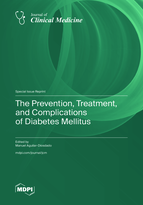The Prevention, Treatment, and Complications of Diabetes Mellitus
A special issue of Journal of Clinical Medicine (ISSN 2077-0383). This special issue belongs to the section "Endocrinology & Metabolism".
Deadline for manuscript submissions: closed (15 November 2023) | Viewed by 60863
Special Issue Editor
Interests: diabetes mellitus; thyroid diseases; metabolic syndrome; complications
Special Issue Information
Dear Colleagues,
We invite you to participate in this Special Issue of JCM on “Prevention, Treatment, and Complications of Diabetes Mellitus”. As you well know, diabetes mellitus (DM) is a major health problem and, due to complications, is one of the leading causes of blindness, kidney failure, and lower limb amputation. Furthermore, DM notably increases the risk of developing cardiovascular disease and reduces the quality of life.
Although the prevention of type 2 DM based on lifestyle criteria (e.g., nutritional recommendations and physical activity) is well established, no such approaches have yet been demonstrated for type 1 DM, and there are currently no firm proposals for transferring efficient prevention measures to clinical practice.
Regarding treatment, that for type 1 DM continues to be based on insulin therapy with multiple injections or on the implantation of continuous insulin infusion systems, and for both, the application of sensors that continuously determine glucose levels represents a remarkable advance for metabolic control. On the other hand, the treatment of type 2 DM has become more complex, with multiple proposals oriented toward individualization depending on the characteristics of the patient (age, comorbidities, weight, empowerment, and cost).
We look forward to receiving your submissions to this Special Issue.
Prof. Dr. Manuel Aguilar-DiosdadoGuest Editor
Manuscript Submission Information
Manuscripts should be submitted online at www.mdpi.com by registering and logging in to this website. Once you are registered, click here to go to the submission form. Manuscripts can be submitted until the deadline. All submissions that pass pre-check are peer-reviewed. Accepted papers will be published continuously in the journal (as soon as accepted) and will be listed together on the special issue website. Research articles, review articles as well as short communications are invited. For planned papers, a title and short abstract (about 100 words) can be sent to the Editorial Office for announcement on this website.
Submitted manuscripts should not have been published previously, nor be under consideration for publication elsewhere (except conference proceedings papers). All manuscripts are thoroughly refereed through a single-blind peer-review process. A guide for authors and other relevant information for submission of manuscripts is available on the Instructions for Authors page. Journal of Clinical Medicine is an international peer-reviewed open access semimonthly journal published by MDPI.
Please visit the Instructions for Authors page before submitting a manuscript. The Article Processing Charge (APC) for publication in this open access journal is 2600 CHF (Swiss Francs). Submitted papers should be well formatted and use good English. Authors may use MDPI's English editing service prior to publication or during author revisions.
Keywords
- diabetes mellitus pathogenesis
- diabetes mellitus complications
- diabetes mellitus prevention
- diabetes mellitus treatment
- prevention of diabetes complications







